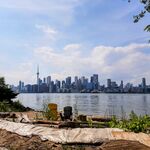Glen
Senior Member
Avenues proposals are cropping up left right and centre if you pay attention to project postings here on UT.
Toronto has many good plans. What it is missing is a reality that will see them come to fruition.
Avenues proposals are cropping up left right and centre if you pay attention to project postings here on UT.
Markham opted for 60% intensification, for example, while Vaughan is just a bit over the 40% minimum.
Yes, it is very good to see Vaughan doing something other than sprawl. By the way, I wrote a letter to Vaughan council commending them on their plans and opposing sprawl, and I would reccomend that anybody else in Vaughan do so as well.
Each occupying what percentage of the municipalities they belong to? What of the rest of the said municipalities? And just how successful are these plans thus far when it comes to the ultimate policy goals of reducing gridlock and conservation? I mean, I live in Mississauga - for all the planning at MCC, just how many pedestrians have you seen walking around even on a good day? And for all the chest pounding, what is the modal split in Sauga...MCC or Port Credit even? Just saying.
I visited various architectural firms (dTAH, Bortolotto, Diamond & Schmitt, to name few) today for Doors Open T.O. today, and I can make a response to your statement [especially the last one].
About VMC, MCC and RHC; granted, they are not as close to 10% of the entire municipality area. But for rest of the communities in Sauga, Brampton, or in fact, all Ontario municipalities, once the master plans proceed as planned I think we need no complaints here (and my "trolling comment" about Waterfront can be put to rest).
As glen said "a missing thing is a reality to be made into fruition", only time tells. And I do hope that several plannings are underway (even if I don't know well) outside intensification areas. And yes, the total percentage of preferred transportation is still favours the automobiles, but look to the brighter side, Sauga's public transportation and other non-automobile modes have increased too (source: as latest as 2006)!
And as for your point about pedestrians and cyclists in MCC, it sounds to me that you are ignoring the growth of Mississauga (apologized in case you took this as offence). Compared to my arrival in Canada in '98, major things changed. Back in those times, it was no better than a wasteland. Now, I see no less than a fifth of peds (approx.) you'd see in Bloor West Village. That's a major remarkable change, and according to my observation! Never mind that I still jaywalk for comfort and convenience around busy B'hamthorpe and Hurontario. The more I see the Confederation, Duke of York and Rathburn, the more it feels closer to "more developed" Central Etobicoke, STC and even Bayview/Sheppard!
What does visiting any of those said architecture firms has anything to do with responding to what I have said, exactly?
Really? Like Cornell or the various NU developments (at best) perhaps? Or how about master planned developments such as Erin Mills? You make master planning sounded like some magical tool that leads to urban utopia - sorry, historically the record is rather mixed. And let's not even get me started about how many elements of say the Erin Mills plan that haven't been followed through.
And ridership on MT has just dropped in the neighbourhood of 2M last year...
No offense to you, but I have lived in Mississauga since 92 and is still living there - and it will be a challenge to find even 1/10th the number of pedestrians in Bloor West Village even on a good day (like this afternoon) in MCC - in spite of the dramatic increase in residential population. I use MT daily, and workout at the Sauga Y regularly, I *know* the usual amount of pedestrians in the MCC area, believe me.
And what do you mean by "more developed", exactly? And why limit yourself to these rather third rate examples of urban development? If anything one should be using the Port Credit and hell, even the Streetsville model instead.
Meh this is silly ... at the end of the day it's good a *plan* is being put in place in Vaughan, just as it's good there's a plan for MCC and the like (same goes for the portlands). Why are we comparing the different areas here, are they competing against each other? For business sure (and we know who's losing that battle... Toronto is, just to be clear), but in terms of anything else (residence that is) no, not really (though you can argue a loss of business will contribute to this but that's another matter) - at the end of the day, 30 years from now, I fairly confident people who want to live downtown / Y&E and the like will stall want to live in those locations, and people who want to live in MCC will still live there, and the multitude greater amount of the general public who want to live in houses with yards will live throughout the GTA at these exist everywhere.
I never said that today's master plans are the "holy grail of urban development". Then again, following the past consequences of such developments, running away from it rather than resolving the issue is to me, a more threshold to my ears. A defeat to the purpose of urban planning.
And Erin Mills? Please give me your insights about that area (although it's different from MCC in some degrees, can you at least elaborate on that for bit since you are familiar with the area [or the entire city as a whole])?
nd none as come as close to early Toronto's early models (1800's~pre-1940's)... Although PC and Streetville is apparently successful in some degrees, in just how what criteria does it reach to be proclaimed as a "divine plan??" What does it must have to be perfectly a good "community"? Copy & paste Streetsville all over the GTA? And just what you mean about "third-rate" example of urban development? You mean the current master plan of 905 municipalities are awful as the suburban sprawl in GTA? Another form of "sprawl" masquerading as "sustainable planning?"
Then again, I think there has to be synergy between the real urban area to suburban areas... There's too many issues yet to be resolved in this case.
Moderator (AoD), I am not bashing, insulting or demeaning your stance; I am interested to hear just what to you, is really a better alternative to VMC or similar projects across GTA. I still have decades before I really know urbanization. And please don't take any of my replies above as an attack. But really, just because my observation is slight a bit off (at best), must this be taken to the extreme-st point?




